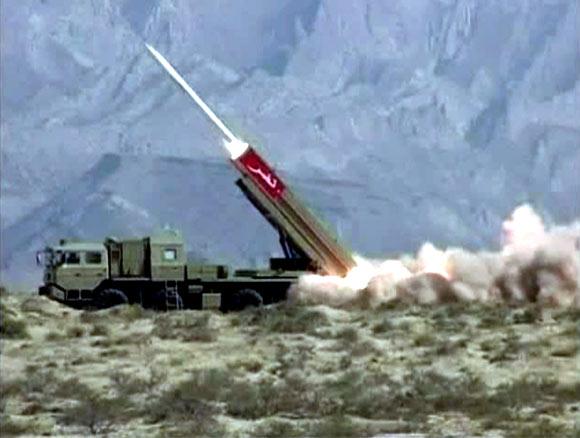
Pakistan's maneuvers will force both sides, at tremendous cost, to upgrade their state of strategic readiness in the early stages of conflict or military standoff, creating a dangerous escalatory scenario, according to Brigadier (retd) Arun Sahgal and Rahul Bedi
Pakistan's proliferating nuclear arsenal, which is fast emerging as the world's fifth largest stockpile backed by technologic improvements in their delivery means and re-nuanced doctrinal changes for their employment against India, pushes New Delhi into a competitively disadvantageous position even on the conventional military front.
This proliferating nuclear arsenal asymmetry, in turn, could impel Pakistan into engaging in a game of brinkmanship in any conflict scenario with India. This ought to be a cause of concern to India's stasis-riven political and strategic establishment.
According to international estimates, there is a rapid lop-sidedness developing between Indian and Pakistani strategic assets.
According to the latest Global Fissile Material report and the Stockholm International Peace Research Institute, Pakistan could have as many as 100-130 nuclear weapons by 2013. India is estimated to have only 80-100 such weapons.
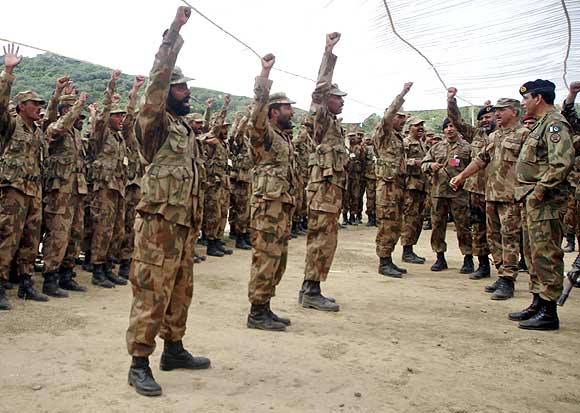
This number could, however, rise significantly once the Chinese-enabled enrichment facilities at Khushab II go on stream over the next two years, providing Pakistan with an additional 25 kg of weapons grade plutonium, appreciably augmenting its strategic weapons inventory.
Pakistan is also upgrading its missile production capability. The Beijing-aided National Development Complex at Fatehjang, located southwest of Islamabad in the Kala Chatta hills, annually produces nearly 12-14 Ghaznavi and Shaeen I and II short-to-medium range nuclear capable ballistic missile systems with strike ranges extending from 290 km to over 2,000 km.
Alongside, Pakistan has disturbingly shifted the sub-continent's strategic goalposts by developing tactical nuclear weapons like the short range, surface-to-surface Hatf IX NASR missile, purportedly to counter India's conventional, pre-emptive offensive 'Cold Start' doctrine.
It tested NASR's operational deployment to a 60 km strike range during the third edition of the Azam-e-Nau (New Resolve) military manoeuvres in May, revealing that two of these tactical missiles can be fired from a single, mobile transporter erector launcher.
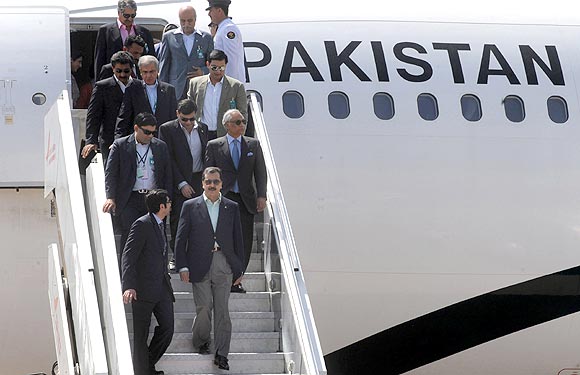
Operationalising NASR also reflects Pakistan's capacity to miniaturise warheads, which in turn disturbingly signifies that Babur and Raad (Thunder), its land and air attack cruise missiles, too can be rendered nuclear capable.
Additionally, navigation and enhanced surveillance inputs available from Chinese space based assets would provide Pakistan a potent second strike capability in addition to its first strike option against India's retaliatory, no-first use doctrine.
Apart from short circuiting the strategic decision cycle by downgrading it to battlefield operational levels, the introduction of tactical nuclear weapons seriously jeopardises the region's 'stability and instability' paradigm by considerably increasing the risk of accidental launches based merely on misperceptions.
It would also force the two sides, at tremendous cost, to upgrade their state of strategic readiness in the early stages of conflict or military standoff, creating a dangerous escalatory scenario.
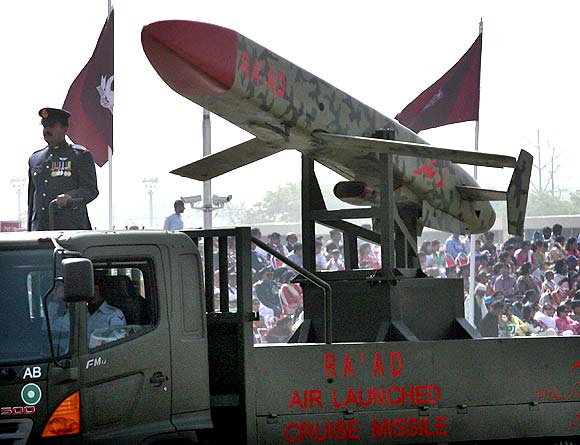
Pakistani planners obviously believe that gains accruing from such a strategic maneuver, euphemistically termed' nuclear overhang', would be sufficient to contain a conventionally stronger India.
These moves by Islamabad also raise the crucial issue of Pakistan's doctrinal approach to nuclear weapons and the various drivers shaping it.
Firstly, without doubt, Pakistan's nuclear arsenal is India-specific with its leadership reiterating that Islamabad would be forced into employing weapons of mass destruction if either its military, economic or national survival thresholds were threatened or breached.
Secondly, sanguine in its growing strategic capabilities, Pakistan appears to have manoeuvred a major doctrinal shift from its earlier 'fist strike' to 'first strike followed by second strike' doctrine.

Essentially, this shift implies that Pakistan's nuclear command authority is convinced over the credibility of its second strike potential even after absorbing India's retaliatory strike.
This brashness and overconfidence appear almost certainly to be bolstered by the 'launch-on-warning' capability provided by military and nuclear ally China.
Pakistani offensive strategic planning is driven principally by India's burgeoning material acquisitions and the perceived modernisation and augmentation of its technological and cyber-warfare capabilities, which, Islamabad fears, could result in a conventional escalation potentially rendering it operationally disadvantaged.
Hence, faced with an inadequate conventional riposte, Pakistan's military-centric planners believe that rather than face national ignominy or even worse, military defeat, it left them with no option but to resort to nuclear brinkmanship via deployment of tactical nuclear weapons.
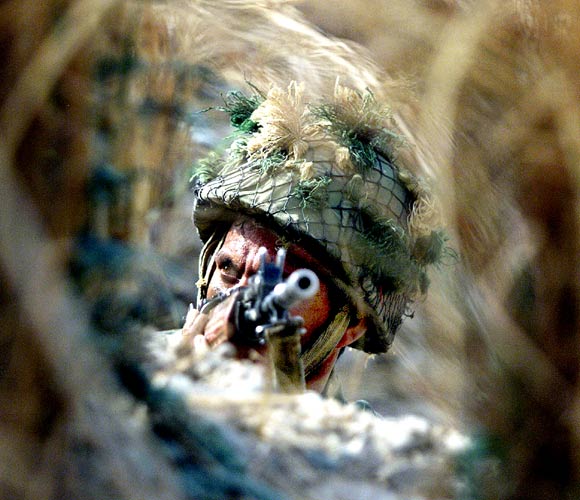
Islamabad's strategic thinking further appears to be attenuated by factoring in the possibility of India's pre-emptive response strategy in the event of a Rawalpindi-backed Mumbai-like incident.
It remains decidedly concerned that in such an eventuality, its lack of conventional capability could deliver to India sizeable territorial gains under its 'Cold Start' doctrine.
This envisages the strategy of employing well-accoutered holding or pivot formations along India's frontier with Pakistan moving swiftly on the offensive in a 'limited war' scenario to achieve negotiable military gains in a strategic weapons environment.
In this respect Pakistan's planning appears to be shaped by North Atlantic Treaty Organisation's Cold War nuclear doctrine, wherein, faced with the Soviet military's

Similarly, Pakistan is attempting to mirror NATO's Cold War logic both of low thresholds and ambiguity to dissuade India from launching pre-emptive strikes, putting Delhi's political and strategic establishment in a quandary.
Pakistan's principal endeavour in this sphere is to severely contract, if not totally depreciate India's 'Limited War' scenario propagated by successive military commanders.
Pakistan is simply raising the stakes of strategic balance in the region to new and dangerous levels, leaving India no option but to respond likewise.
India's recent testing of multiple short-to-medium range missiles like Prahar (attack), Shourya (Courage) and Prithvi 2 -- all with potential nuclear capability -- is intended to send out the message that Delhi too can play high stakes poker at the tactical level.
But it is equally important for Islamabad to comprehend the dangers and ramifications of its escalatory nuclear doctrinal thinking while in contrast India's concerns remain complex and multi-pronged.

For Delhi needs to develop its strategic response centered not only round nuclear challenges emanating from Islamabad but concomitantly also those originating from China.
It must be acknowledged that it is at China's behest that Pakistan is attempting to leverage its nuclear proliferation and doctrinal shift in order to push India towards a nuclear restraint regime potentially with subtle but cunningly considered spin-offs in maintaining a conventional military balance and resolving the outstanding 'nuclear flashpoint' dispute over Jammu and Kashmir.
This sinister aim in light is maturing as part of the wider Sino-Pakistan gambit aimed at ensuring that South Asia's military balance of power results in a 'confined' India, which in no way can threaten China's security along its relatively vulnerable southwestern frontier.
In this respect too a pliant and willing Pakistan is allowing itself to be used as a Chinese proxy mindless of the high economic and political price it entails.